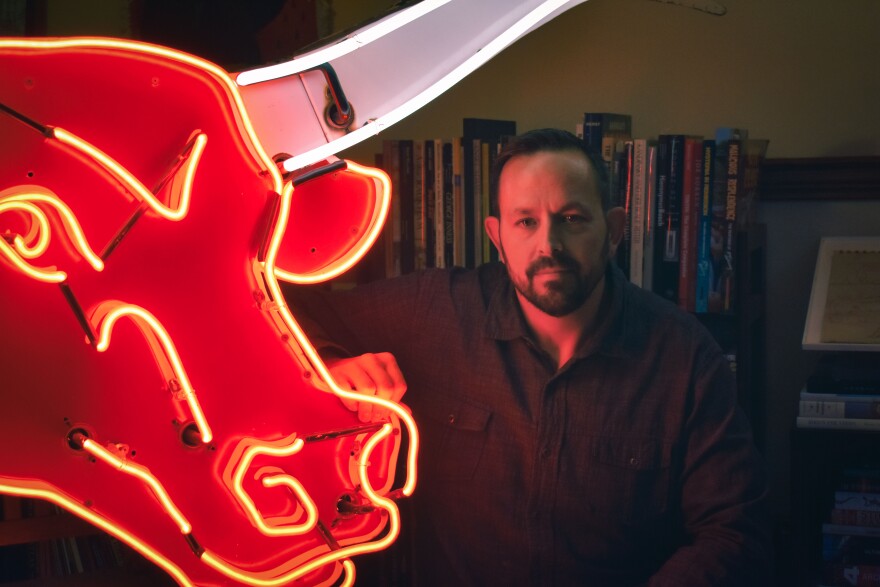Neon and Nevada go hand in hand. The flashing tube lights are synonymous with the Silver State and have long told our story. Neon has surged in popularity at times and fizzled out in others. KUNR's Arts and Culture Reporter Holly Hutchings has been looking into this integral part of Nevada's identity and talked with News Director Michelle Billman about the stories she’s discovered.
The story of Neada has long been illustrated in vivid, electric neon. When traversing the vast deserts of the Silver State, glowing beacons radiate as oases of pleasure and respite in an otherwise desolate landscape. The vibrant rainbow ambiance emitted from neon has welcomed travelers and guests since the twenties and endures, somewhat, to present day.
In the mid-century, when the rest of the country was abandoning neon for plastic signage, Nevada only doubled down on its neon structures and turned its efforts ablaze. That time brought about some of the tallest, most recognizable neon icons we still marvel at today.
If there was no neon, you could be anywhere. But you’re in Nevada, and Nevada = Neon.
However, neon is disappearing across the state, and when neon signs are still standing, they are often dilapidated or half-operational. The signs that once advertised heated pools, friendly bars and even courthouses and cemeteries, are dwindling. Some estimates suggest that Reno has lost about a dozen signs in just the last couple of years as developers raze old properties in the name of progress. Currently on Fourth Street in Reno, the Mardi Gras Motel came down and the Lido Inn is next in line as the Jacobs Entertainment’s project moves along.

Is the maverick, blazing craft out of date? Have styles changed to the point that neon is viewed as tacky, gawdy and in need of revamping? What is happening to neon in Nevada?
Well, a lot, actually.
Although tastes have evolved, and neon has lost some of its cultural sparkle, the future of neon is brighter than one might think and appreciation for the craft is on the upswing. More signs are being saved and treasured than once before.
One Reno preservationist - who some call the 'guardian angel of the signs' - is capturing much of this architecture before it hits the landfill. Will Durham, Executive Director of The Nevada Neon Project, has some 100 signs from Elko to Vegas, Wells to Reno. He watches properties doomed for destruction, and then works with sign companies to safely remove the signs and nabs them before they’re lost. His nonprofit is planning a modern neon museum in Reno, which would bring the signs back to their full brilliance and show them off.
“They’re not just these obsolete relics; they are, actually, artistically and historically significant,” Durham said.

“People are intrigued by the neon story in Nevada, and there's room for that story to be told in different ways. The museum in Las Vegas, they do a wonderful job of telling the Las Vegas version of that story, but this is a big state and there’s a lot of different characters and different historical properties, and there's a lot more to be told. I think the story, to me, is a lot richer when you take in the whole state, and Reno had a real history. We had the largest casinos in the world for a long time; we were the entertainment capital, so this a nice way to honor Reno's history, as well."
Historical buffs and preservationists in Reno are also watching the signs. Ideally, the signs and buildings attached would be preserved, still standing. ZoAnn Campana is the vice president of the board of directors of the Reno Historic Preservation Society.
“They're so important,” Campana said. “When you think about Reno in its heyday, you could drive down Fourth Street at night, and the whole corridor would be lit up by these vivid, colorful neon lights. It's not something we see so much anymore. We still have the neon signs, but they're not really lit up very often. It's something that's very deeply tied to our history, and, especially, when you consider that Reno's history is tied so closely with the history of transportation and that we were on the transcontinental highway. Those neon signs are really becoming a thing of the past.”
Although the signs are coming down in large numbers, there are also many efforts to bring the classic craft back into the spotlight. The University of Nevada, Reno has offered courses that focus on researching the neon pieces in the region, as well as the design and typography that go into these signs. A digital archive documenting and digitally preserving the history of the signs’ typography and design is also in the works. Professor Katherine Hepworth says the site she's working on with UNR History Professor Christopher Church and UNR Libraries will serve as an educational resource of what was once here, as well as chronicle the ongoing losses.

The Reno Type Archive will be a digital archive of Reno’s rich design history, based on the type, or font for a layperson, that has been used in the signs over time. Hepworth says the type tells the story of the changing economics and social makeup of the region, as well as the different groups that have used typefaces to convey their stories.
“I want this history of Reno signs to be available to people, whether they can afford the gas to go to the museum, whether they have the physical ability to go to the museum, whether they are a kid in a rural location in Nevada,” Hepworth said. “I want this important aspect of Nevada history to be, if not as accessible, nearly as accessible to people in remote locations.”
These and other efforts will be an ongoing focus of our series, Sparked: Northern Nevada’s Neon through the month of April.







